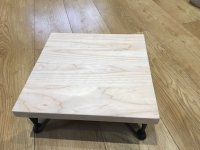if you want to bolt into concrete you have a couple of choices.
Cheap, but inflexible (and likely to go wrong), Stick a couple of large square washers on the end, with double-locking nuts, and cast into the concrete, hope you get it in the right place, and at the right angle, and that it doesn't get knocked until the concrete has set, or when you vibrate the concrete to compact it.
Next is to use a holding-down bolt. Same as above, but less heath robinson as the bolt is pre-made.
Next is to use a holding-down bolt with adjustment cone collar. Same as above, but it has a cone that allows for small adjustment after the concrete has set. You then grout the void once the fitting is in place so you know it's in the right position and orientation
Next is to use a coupler socket. So you cast in a socket with the female end (covered by a plastic cap) and pour the concrete. Then you come along with your thing to mount, pop the cap off and screw it up. You can attach the sockets to some rebar or similar rigid frame that gets cast into the concrete to keep them in position during the pour. Downside, couplers can be a bit large, but not too bad for M8. They can also be expensive if you're not buying in bulk. NB to leave enough concrete cover around them too so they don't crack thin concrete and grin out at you
Last, but not least, don't cast anything in. Post-fix by drilling and using resin-anchored fixings, like Hilti or Fosroc or similar anchors. For low forces (eg furniture) the embedment required can be quite low, even 50-60mm into concrete. You could also consider expanding anchors or concrete nails for non-structural uses too. All of which are likely to be easier than casting-in to any precision.
Scratch all that I've misunderstood I think - you want to cast the legs into the top?
Add square plate washers onto the rods and captive nuts either side (pairs of nuts locked together by counter rotating to set the washer position)
embed those into the concrete and reinforce the areas with some orthogonal mesh.
pour concrete upside down so to speak, you'll get your best finish on the mould faces, so ply and wax coat (or even wax paper) line the mould and cast it on the ground with the legs held upside down and held in position by a jig. Vibrate the mould or use a poker to get a good compaction, but don't overwork or you'll get too much separation. Tamp and float skim the top, which will be the underside once you turn the thing the right way up after the concrete has set.
Like most things preparation is key. Really seal the formwork moulds to prevent grout loss and check and double check you have an even coating of any surface agents/liners. Some mottling will be inevitable, but it often fades with time.
what are the overall dimensions you're looking at, and what do you want it to carry?
Also I wouldn't use postcrete for furniture etc. Post crete sets fast but can weaken with age (depending on the constituents in the mix). For garden furniture you may not care, but cheaper more regular ready mix may give a better workability and finish, just with a slightly longer setting time.


